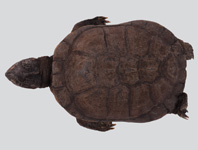Abstract
Recent research has shown that the helmeted terrapin (Pelomedusa subrufa), a species that occurs throughout sub-Saharan Africa, in Madagascar and the southwestern Arabian Peninsula, consists of several deeply divergent genetic lineages. Here we examine all nominal taxa currently synonymized with Pelomedusa subrufa (Bonnaterre, 1789) and provide mitochondrial DNA sequences of type specimens or topotypic material for most taxa. Lectotypes are designated for Testudo galeata Schoepff, 1792, Pentonyx capensis Duméril & Bibron, 1835, Pelomedusa nigra Gray, 1863, Pelomedusa galeata var. disjuncta Vaillant & Grandidier, 1910, and Pelomedusa galeata damarensis Hewitt, 1935. For Pelomedusa gasconi Rochebrune, 1884, a taxon without preserved type material, a neotype is designated. Type material of Pentonix americana Cornalia, 1849, a nominal species without credible type locality, is lost and its identity remains questionable. Also the holotype of Pelomedusa galeata orangensis Hewitt, 1935 is lost, but its allocation to the only genetic lineage occurring in South Africa is unambiguous. Phylogenetic analyses of type sequences or topotypic material reveal that the remaining nominal taxa represent three of the nine previously identified lineages of Pelomedusa. Among these three lineages is the South African one. Type specimens of Pentonyx gehafie Rüppell, 1835 correspond to an additional distinct lineage. The present study provides a sound basis for a subsequent integrative taxonomic revision of the Pelomedusa complex.

